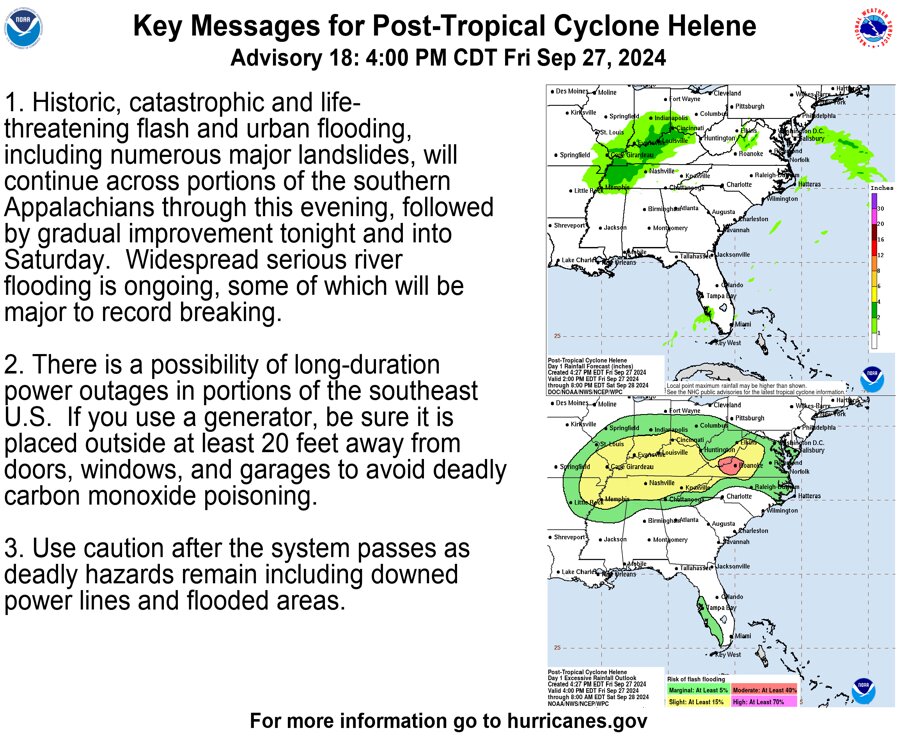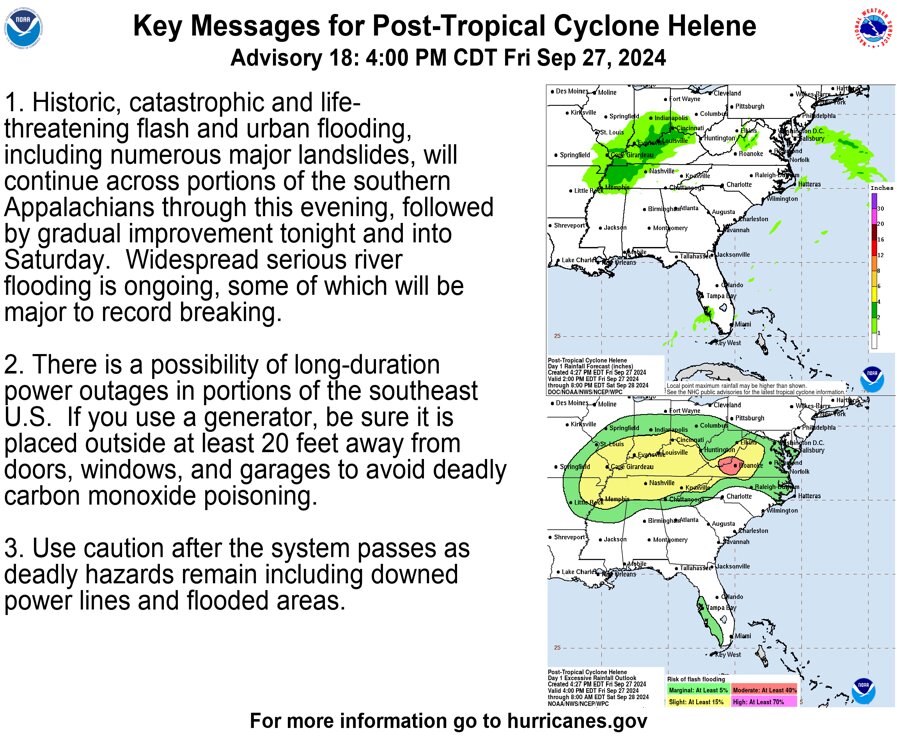Immediate damage from a hurricane is evident, but environmental impacts can linger – The Augusta Chronicle

Report on Hurricane Impacts and their Relation to Sustainable Development Goals
This report outlines the significant environmental and societal impacts of hurricanes, with a specific focus on their implications for achieving the United Nations Sustainable Development Goals (SDGs). Data indicates that hurricanes, intensified by climate change, pose a direct threat to public health, environmental stability, and community resilience.
Impacts on Public Health, Water, and Infrastructure
SDG 3: Good Health and Well-being & SDG 6: Clean Water and Sanitation
Hurricanes severely compromise public health and sanitation systems, directly impeding progress on SDG 3 and SDG 6. The primary mechanisms of impact include widespread contamination of essential resources.
- Water Contamination: Storm surges and heavy rainfall overwhelm sewage treatment plants, leading to the release of raw or partially treated sewage into floodwaters. This contaminates surrounding soil and critical water sources.
- Hazardous Material Release: Industrial sites are vulnerable to flooding, which can cause storage tanks to leak chemicals. Damaged equipment may also lead to fires and the release of noxious fumes.
- Agricultural Runoff: Floodwaters carry fertilizers and pesticides from agricultural areas into waterways, contributing to eutrophication and harming aquatic life, which in turn affects water quality for human use.
- Public Health Risks: Exposure to contaminated floodwaters and soil poses long-term health risks. Documented health problems include respiratory illnesses, skin infections, and gastrointestinal issues.
Ecological Disruption and Biodiversity Loss
SDG 14: Life Below Water & SDG 15: Life on Land
The ecological damage caused by hurricanes presents a major setback for the preservation of marine and terrestrial ecosystems, as outlined in SDG 14 and SDG 15.
- Habitat Destruction: Storm surges and flooding cause significant erosion of shorelines and coastal areas. The resulting sediment and debris are carried into waterways, degrading water quality and destroying vital habitats.
- Marine Ecosystem Degradation: Hurricanes alter the chemical balance of marine environments by lowering salinity and oxygen levels, rendering them unsuitable for many native species.
- Introduction of Invasive Species: Storm systems can transport invasive plants and animals to new areas, disrupting the balance of local ecosystems and threatening native biodiversity.
Climate Change and Disaster Resilience
SDG 11: Sustainable Cities and Communities & SDG 13: Climate Action
The increasing frequency and intensity of hurricanes, linked to climate change, undermine efforts to build resilient communities and take urgent climate action, central tenets of SDG 11 and SDG 13.
- Climate Change as an Intensifier: Experts confirm that climate change exacerbates hurricane impacts. Warmer ocean waters provide more energy for storms, while a warmer atmosphere holds more moisture, leading to heavier rainfall and increased flood risk.
- Threat to Community Resilience: The destruction of infrastructure, including industrial sites and sanitation facilities, compromises the ability of communities to withstand and recover from natural disasters, a key target of SDG 11.
- Need for Climate Action: The link between climate change and more destructive hurricanes underscores the urgency of SDG 13, which calls for immediate action to combat climate change and its impacts. Rising sea levels further compound the threat by exacerbating storm surge and coastal flooding.
Sustainable Development Goals (SDGs) Addressed
The article highlights several environmental and health-related consequences of hurricanes, which directly and indirectly connect to a range of Sustainable Development Goals. These goals focus on health, water quality, climate change, and the protection of ecosystems.
-
SDG 3: Good Health and Well-being
The article connects to this goal by detailing the health risks posed by hurricane-induced pollution. It states that “contaminated soil and water can pose long-term health risks to communities” and “exposure to contaminated floodwaters can cause a range of health problems, including respiratory illnesses, skin infections, and gastrointestinal issues.”
-
SDG 6: Clean Water and Sanitation
This is a central theme, as the article extensively discusses water contamination. It mentions that hurricanes can “overwhelm sewage treatment plants, releasing raw or partially treated sewage into floodwaters,” and that flooding carries “agricultural runoff, including fertilizers and pesticides, into waterways.” This directly impacts the availability of clean water and the functioning of sanitation systems.
-
SDG 11: Sustainable Cities and Communities
The article touches upon the vulnerability of urban and industrial infrastructure to natural disasters. It notes that hurricanes can “flood industrial sites, causing storage tanks to leak” and “damage equipment, causing fires and the release of noxious fumes.” This relates to making cities and human settlements resilient to such disasters.
-
SDG 13: Climate Action
The article explicitly links the increasing intensity of hurricanes to climate change. It quotes the Environmental Defense Fund, stating, “Climate change intensifies hurricanes by increasing their strength, rainfall, and storm surge.” This directly addresses the need for action to combat climate change and its impacts.
-
SDG 14: Life Below Water
The impact on marine ecosystems is clearly outlined. The article mentions that storm surges “erode shorelines and coastal areas,” which impacts “water quality and habitats.” It also notes that hurricanes can “lower salinity and oxygen levels in marine ecosystems” and that agricultural runoff causes “eutrophication and harming aquatic life.”
-
SDG 15: Life on Land
The article discusses the degradation of terrestrial and freshwater ecosystems. It points out that contaminated water can spread to “contaminating soil and water sources.” Furthermore, it highlights a direct threat to biodiversity by stating that hurricanes can “transport invasive plants and animals to new areas, disrupting local ecosystems.”
Specific SDG Targets Identified
-
Target 3.9: By 2030, substantially reduce the number of deaths and illnesses from hazardous chemicals and air, water and soil pollution and contamination.
This target is relevant because the article explicitly describes how hurricanes lead to the release of “hazardous materials from industrial sites,” “noxious fumes,” “raw or partially treated sewage,” and “fertilizers and pesticides.” It directly links these releases to health problems like “respiratory illnesses, skin infections, and gastrointestinal issues.”
-
Target 6.3: By 2030, improve water quality by reducing pollution, eliminating dumping and minimizing release of hazardous chemicals and materials.
The article’s focus on the contamination of waterways aligns perfectly with this target. The text details how hurricanes cause the release of chemicals from industrial storage tanks, sewage from treatment plants, and agricultural runoff, all of which degrade water quality.
-
Target 11.5: By 2030, significantly reduce the number of deaths and the number of people affected and substantially decrease the direct economic losses relative to global gross domestic product caused by disasters, including water-related disasters.
Hurricanes are a prime example of the water-related disasters this target addresses. The article’s entire premise is about the destructive and lingering impacts of these storms on communities and the environment, implying the need to mitigate these effects.
-
Target 13.1: Strengthen resilience and adaptive capacity to climate-related hazards and natural disasters in all countries.
By explaining how climate change makes hurricanes more destructive (“Warmer ocean waters provide more energy for storms to intensify”), the article underscores the importance of building resilience against these intensifying climate-related hazards.
-
Target 14.1: By 2030, prevent and significantly reduce marine pollution of all kinds, in particular from land-based activities, including marine debris and nutrient pollution.
The article describes land-based pollution sources, such as “agricultural runoff, including fertilizers and pesticides,” and sewage being carried into waterways that ultimately affect marine environments. This directly relates to preventing marine pollution from land-based activities.
-
Target 14.2: By 2020, sustainably manage and protect marine and coastal ecosystems to avoid significant adverse impacts.
The text highlights several adverse impacts on these ecosystems, including how storm surges “erode shorelines and coastal areas,” which affects habitats, and how hurricanes can “lower salinity and oxygen levels in marine ecosystems, making them less suitable for many species.”
-
Target 15.8: By 2020, introduce measures to prevent the introduction and significantly reduce the impact of invasive alien species on land and water ecosystems.
This target is directly addressed by the statement that hurricanes “can transport invasive plants and animals to new areas, disrupting local ecosystems.”
Indicators for Measuring Progress
While the article does not mention official SDG indicators, it implies several metrics that could be used to measure progress towards the identified targets.
-
Incidence of Water-Borne Diseases and Illnesses
The article’s mention of “respiratory illnesses, skin infections, and gastrointestinal issues” following exposure to contaminated floodwaters implies that tracking the number and types of these health problems post-hurricane would be a key indicator for Target 3.9.
-
Water Quality Degradation
The discussion of sewage, chemical, and agricultural runoff contaminating waterways suggests that measuring water quality parameters (e.g., levels of pollutants, nutrients, pathogens) in affected areas before and after a hurricane would serve as an indicator for Target 6.3.
-
Impact on Marine and Coastal Ecosystems
The article’s description of shoreline erosion, lowered oxygen levels, and habitat damage suggests that indicators for Target 14.2 could include measuring the extent of coastal erosion, changes in water salinity and oxygen levels, and assessing the health of coastal habitats after a storm.
-
Introduction of Invasive Species
The statement that hurricanes can transport invasive species implies that an indicator for Target 15.8 would be the detection and monitoring of new, non-native species in ecosystems affected by hurricanes.
Summary Table of SDGs, Targets, and Indicators
| SDGs | Targets | Indicators (Implied from Article) |
|---|---|---|
| SDG 3: Good Health and Well-being | 3.9: Reduce illnesses from hazardous chemicals and pollution. | Incidence of respiratory illnesses, skin infections, and gastrointestinal issues post-hurricane. |
| SDG 6: Clean Water and Sanitation | 6.3: Improve water quality by reducing pollution. | Levels of chemical, sewage, and agricultural pollutants in waterways after a storm. |
| SDG 11: Sustainable Cities and Communities | 11.5: Reduce the number of people affected by disasters. | Number of communities affected by flooding, contamination, and infrastructure damage. |
| SDG 13: Climate Action | 13.1: Strengthen resilience to climate-related hazards. | Frequency and intensity of major hurricanes causing environmental damage. |
| SDG 14: Life Below Water | 14.1: Reduce marine pollution from land-based activities. 14.2: Protect marine and coastal ecosystems. |
Measurement of nutrient and chemical pollution in coastal waters; extent of shoreline erosion and habitat degradation. |
| SDG 15: Life on Land | 15.8: Prevent the introduction of invasive alien species. | Number of new invasive species detected in affected ecosystems post-hurricane. |
Source: augustachronicle.com

What is Your Reaction?
 Like
0
Like
0
 Dislike
0
Dislike
0
 Love
0
Love
0
 Funny
0
Funny
0
 Angry
0
Angry
0
 Sad
0
Sad
0
 Wow
0
Wow
0

















































:focal(1500,1000)/https://media.globalcitizen.org/a6/9a/a69a4720-d8a1-4715-b596-18738d03c05c/rotary_polio_hero_image.jpg?#)






/countries/sri-lanka/photo-credit---dmc-sri-lanka.tmb-1200v.jpg?sfvrsn=dc298bcc_1#)

















